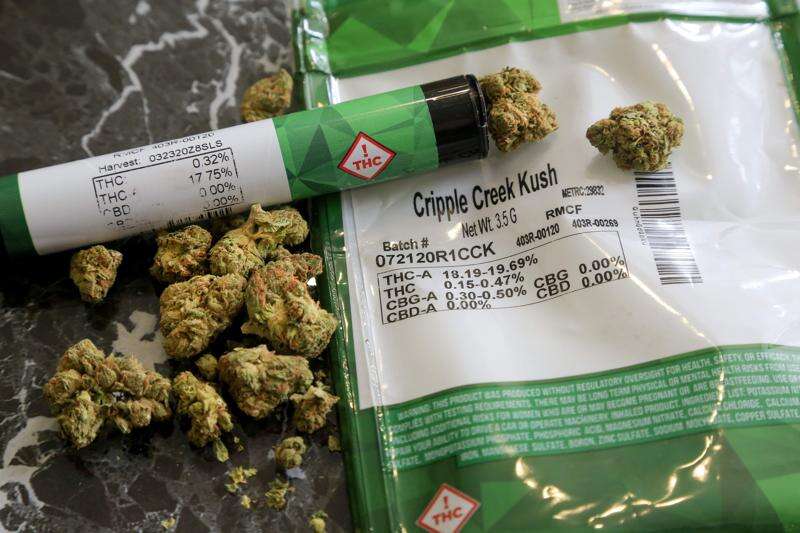Forget the pandemic boom in marijuana sales – Colorado now collects fewer marijuana tax dollars than it did in 2018.
About half the country now has joined Colorado in legalizing recreational marijuana, with a total of 24 states and Washington, D.C., regulating cannabis. The spread of legalization has taken a toll on Colorado’s more established market, with the wholesale price of legal marijuana falling to its lowest recorded level, according to state budget documents.
But a new analysis by Joint Budget Committee staff found that there’s another factor to blame for the decline of Colorado’s marijuana industry: the rise of intoxicating hemp.
In 2018, Congress legalized hemp through the federal Farm Bill, a change that was aimed at allowing its use for things like textiles, not recreational drugs.
There’s a limit on how much THC can be present in legalized hemp. But the federal changes have nonetheless resulted in the creation of a $2.2 billion quasi-legal market for intoxicating hemp products, including THC-infused seltzers, brownies and gummies that are now popping up in gas stations, farmers markets and CBD stores across the country.
For years, budget officials have warned that the boom times would not last once consumer behavior returned to pre-pandemic levels. Today, however, marijuana tax collections have even fallen below what they generated in 2018 and 2019 – and it’s not clear if we’ve reached rock bottom.
The governor’s Office of State Planning and Budgeting expects revenue will finally level off this budget year, increasing slightly to $267 million, then $285 million next year. But Colorado Legislative Council Staff isn’t so sure; they’re projecting tax collections to fall again this budget year to $242 million, before ticking up to $250 million next year.
Not all of that money winds up in the Marijuana Tax Cash Fund, either. In last year’s budget, lawmakers had about $131 million in the fund to spend on things like health services and law enforcement. The rest gets transferred to schools and local governments.
Marijuana taxes are among the few sources of state funding that can grow without restriction in Colorado, because voters exempted them from the Taxpayer’s Bill of Rights revenue cap.
Dried hemp plants are sorted and trimmed at Hepworth Farms in Milton, N.Y., in 2021. In Colorado, hemp faces less regulation meaning intoxicating hemp may be a factor in a noted drop in sales and tax revenue for cannabis. (AP Photo/Seth Wenig)
So in a year where the TABOR cap is going to force the Legislature to make around a billion dollars in spending cuts, the marijuana tax downturn stings.
Last budget cycle, lawmakers already had to cut services funded by marijuana taxes – including a $20 million payment to BEST, a public school construction grant program that the JBC voted to delay until the 2025-26 budget year.
Expect more cuts in the 2025 legislative session.
For starters, Gov. Jared Polis has proposed cutting the BEST payment again – but even that might not be enough to balance the marijuana fund budget.
As of now, JBC staff projects that lawmakers must cut an additional $19 million in marijuana spending from Polis’ budget request to avoid dipping into the fund’s reserves. And that’s under the more optimistic forecast from the governor’s office. If the legislative staff forecast is closer to reality, lawmakers could need to cut more than double that amount.
Colorado’s not alone; other states that were early legalizers of marijuana have seen revenues plummet as well. Sales have fallen 3.3% this year in Washington state, which legalized the drug in 2014, while California’s sales declined 3.4%, according to Cannabis Business Times. But no state saw a decline as large as Colorado’s 8% drop, which saw the industry lose $100 million in annual sales.
The downward trend has put new pressure on budget writers to enact new guardrails around how the money can be spent.
After voters legalized recreational marijuana in 2012, the General Assembly passed a law directing the tax dollars it generated to a handful of areas related to drug use: prevention and treatment programs, public health and safety, and efforts to protect youths from drugs.
But over time, lawmakers have expanded the possible uses for marijuana taxes to as many as 21 categories, including housing, entrepreneurial programs, trial courts and veterans services.
“My first few years in the legislature, it was seen as, oh, that’s where you go to pay for your bills, because there’s not enough general funds,” said JBC chair Jeff Bridges, a Democratic senator from Greenwood Village. “It wasn’t a good thing. And now there’s a bunch of stuff in there that maybe shouldn’t be in there.”




